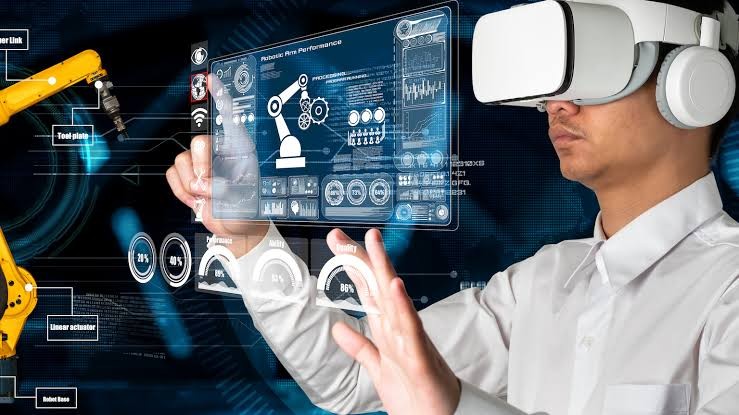What is Augmented Reality?
Augmented Reality is a technology that overlays digital information, such as images, videos, or interactive elements, onto the real-world environment. Unlike Virtual Reality (VR), which creates entirely immersive digital experiences, AR enhances our perception of Reality by blending digital content with the physical world in real-time. This fusion opens up endless possibilities for improving education, entertainment, business, and daily interactions.
Applications Across Industries
AR’s impact spans a wide array of industries, disrupting traditional models and introducing innovative solutions:

-
Gaming:
AR gaming apps have captured the imagination of millions, encouraging players to explore the natural world while interacting with virtual characters and objects. This fusion of gaming and Reality creates an engaging and dynamic experience.
-
Tourism:
Travel experiences are enhanced through AR-guided tours that provide historical context and interactive information about landmarks and attractions, creating a richer travel experience.
-
Education:
Augmented Reality redefines learning by transforming textbooks into interactive 3D models, bringing historical events to life, and enabling virtual field trips. Complex subjects become more understandable as students engage with visual content tangibly.
-
Healthcare:
Medical professionals use AR for surgical planning, where digital overlays help guide procedures with precision. Medical students also benefit from immersive anatomy lessons that aid in understanding complex structures.
-
Retail and E-commerce:
Shopping experiences are elevated through AR, allowing customers to virtually try on clothes, accessories, and cosmetics before purchasing. This not only enhances convenience but also reduces the need for returns.
-
Architecture and Design:
Architects and interior designers employ AR to visualize and present their concepts to clients. With AR, clients can walk through virtual models of buildings and spaces before they are constructed.
-
Advertising and Marketing:
Brands leverage AR to create interactive and engaging campaigns. Scanning a product’s QR code might reveal immersive experiences, special offers, or product information.
-
Manufacturing and Maintenance:
AR assists technicians by overlaying digital instructions on real-world equipment, simplifying complex repair and maintenance tasks.
The Evolution of AR Technology
The rapid evolution of AR technology continues to elevate its capabilities:
-
Spatial Mapping:
AR technology can now map physical environments in real-time, allowing digital content to interact with the surroundings more realistically.
-
Collaborative AR:
Multiple users can now share an AR experience, collaborating and interacting with shared virtual elements in real-time.
-
Wearable AR Devices:
From intelligent glasses to AR-enabled helmets, wearable devices provide a hands-free experience, seamlessly integrating digital information into the user’s field of view.
-
Improved Visual Recognition:
Advanced algorithms enable AR systems to recognize and track objects accurately, making interactions more seamless and intuitive.
The Future of AR
As Augmented Reality continues its meteoric rise, the future holds even more exciting possibilities:
-
Smart Cities:
AR could provide real-time data overlays, helping citizens navigate urban environments and access information about services and events.
-
Cultural Preservation:
Aid in preserving cultural heritage by overlaying historical and contextual information on landmarks and artifacts.
-
AR in Communication:
AR will revolutionize remote communication, allowing users to interact in virtual spaces as if they were physically present.
-
Healthcare Advancements:
Surgeons could perform procedures with real-time AR guidance, improving accuracy and minimizing invasiveness.
-
Entertainment Beyond Gaming:
AR will continue to enrich entertainment experiences through interactive storytelling, immersive theater, and more.
-
Empowerment through Accessibility:
As AR becomes more accessible, it will provide new opportunities for individuals with diverse abilities, enhancing inclusivity.
Conclusion:
Augmented Reality is a transformative force that redefines our perception of Reality and revolutionizes how we interact with the world. Its applications are diverse, and its potential is limitless. As technology advances and creativity flourishes, the storm of AR will continue to captivate and reshape our lives in profound and exciting ways. Embrace the future, where the boundaries between the physical and digital realms blur and new realities are unveiled.
Faqs:
-
Is AR only for gaming?
While AR gaming has gained significant attention, the technology is not limited to gaming. AR is applied in various industries, including healthcare, architecture, design, tourism, and advertising.
-
Can AR be used in education?
Yes, AR has transformed education by offering interactive learning experiences. It brings educational content to life through visualizations, animations, and 3D models, making complex subjects more engaging.
-
Are there privacy concerns with AR?
Yes, privacy is a consideration in AR, and especially when capturing and sharing real-world information. Developers and companies are addressing privacy concerns by implementing secure data-handling practices.
-
What devices are used for experiencing AR?
Many devices, including smartphones, tablets, smart glasses, and wearable headsets specifically made for AR, can be used to enjoy AR experiences.
-
What distinguishes Virtual Reality from AR?
it adds digital elements to the real world, enhancing our current perception, but while Virtual Reality creates a fully immersive digital environment that replaces the real world.
-
How accurate is AR in recognizing objects and environments?
AR technology has improved significantly so in object recognition and spatial mapping. Advanced algorithms enable precise digital content placement in the real world, making interactions more seamless.
-
Are there any safety precautions to consider while using AR?
When using AR in public spaces, and being aware of your surroundings is essential to avoid accidents. Ensure you stay immersed in the digital content and neglect your physical environment.

